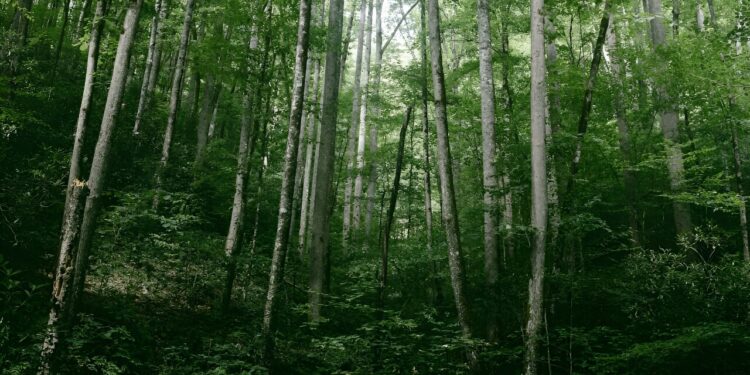A century of forest growth likely helped keep the eastern United States cool as the rest of the country warmed, according to a new study published in The future of the Earth. Credit: Wes Hicks/Unsplash
Widespread 20th-century reforestation in the eastern United States helped counter rising temperatures due to climate change, a new study suggests. The authors highlight the potential of forests as regional climate adaptation tools, essential for reducing carbon emissions.
“This is about how much forests can cool our environment and the extent of that effect,” said Mallory Barnes, lead author of the study and an environmental scientist at Indiana University. “This knowledge is essential not only for large-scale reforestation projections to mitigate climate change, but also for initiatives such as urban tree planting.”
The study is published in the journal The future of the Earth.
Return of the trees
Before European settlement, the eastern United States was almost entirely covered in temperate forests. From the late 18th to the early 20th centuries, timber harvesting and clearing for agricultural purposes led to forest losses exceeding 90% in some areas. In the 1930s, efforts to revive the forests, coupled with the abandonment and then reforestation of poor agricultural fields, marked the beginning of a nearly century-long comeback for the Eastern forests. Since then, around 15 million hectares of forest have grown in these regions.
“The scale of deforestation that has occurred in the eastern United States is remarkable and its consequences are severe,” said Kim Novick, an environmental scientist at Indiana University and co-author of the new study. “There has been a dramatic change in land cover, and it wasn’t that long ago.”
During the regrowth period, global warming was on track, with temperatures in North America rising by 0.7 degrees Celsius (1.23 degrees Fahrenheit) on average. In contrast, from 1900 to 2000, the East Coast and Southeast cooled by about 0.3 degrees Celsius (0.5 degrees Fahrenheit), with the strongest cooling recorded in the Southeast.
Previous studies suggested that the cooling could be caused by aerosols, agricultural activity or increased precipitation, but many of these factors would only explain very localized cooling. Despite the known relationships between forests and cooling, studies have not considered forests as a possible explanation for the anomalous and widespread cooling.
“This widespread history of reforestation, a huge change in land cover, has not been widely studied for how it might have contributed to the anomalous lack of warming in the eastern United States, which climate scientists call a ‘warming hole,'” Barnes said. said. “That’s why we initially decided to do this work.”
The southeastern United States warming gap and corresponding forest conditions. Credit: The future of the Earth (2024). DOI: 10.1029/2023EF003663
Trees are cool
Barnes, Novick and their team used a combination of data from satellites and 58 weather towers to compare forests to neighboring grasslands and croplands, allowing them to examine how changes in forest cover can influence surface temperatures. from the ground and into the few meters of air just above the ground surface. surface.
Researchers found that forests in the eastern United States today cool the land surface by 1 to 2 degrees Celsius (1.8 to 3.6 degrees Fahrenheit) per year. The greatest cooling effect occurs at midday in summer, when trees lower temperatures by 2 to 5 degrees Celsius (3.6 to 9 degrees Fahrenheit), providing relief when it is most needed.
Using data from a network of gas measuring towers, the team showed that this cooling effect also extends to the air, with forests lowering near-surface air temperatures by up to 1 degree Celsius (1.8 degrees Fahrenheit) at noon. (Previous work on the cooling effect of trees has focused on earth temperatures, not air.)
The team then used historical land cover and daily weather data from 398 weather stations to track the relationship between forest cover and ground and near-surface air temperatures from 1900 to 2010. They found that in the late 20th century, weather stations surrounded by forests were up to 1 degree Celsius (1.8 degrees Fahrenheit) cooler than places that did not undergo reforestation. Areas up to 300 meters (984 feet) were also cooled, suggesting that the cooling effect of reforestation may have extended even to non-forested parts of the landscape.
Other factors, such as changes in agricultural irrigation, may also have had a cooling effect on the study region. Reforestation of the eastern United States in the 20th century likely contributed to this cooling anomaly, but cannot fully explain it, the authors say.
“It’s exciting to be able to provide additional information to the long-standing and perplexing question: ‘Why hasn’t the eastern United States warmed at a rate comparable to the rest of the world?'” , Barnes said. “We can’t explain all of the cooling, but we propose that reforestation is an important part of the equation.”
Reforestation in the eastern United States is generally considered a viable climate change mitigation strategy due to the ability of these forests to sequester and store carbon. The authors note that their work suggests that reforestation of the eastern United States also represents an important tool for climate adaptation.
However, in different environments, such as snowy boreal regions, adding trees could have a warming effect. In some places, reforestation can also affect rainfall, cloud cover, and other regional-scale processes in ways that may or may not be beneficial. Land managers must therefore consider other environmental factors when assessing the usefulness of forests as a tool for climate adaptation.
More information:
Mallory L. Barnes et al, A century of reforestation has reduced anthropogenic warming in the eastern United States, The future of the Earth (2024). DOI: 10.1029/2023EF003663
Provided by the American Geophysical Union
Quote: A century of reforestation helped keep the eastern United States cool, study finds (February 13, 2024) retrieved February 14, 2024 from
This document is subject to copyright. Apart from fair use for private study or research purposes, no part may be reproduced without written permission. The content is provided for information only.



